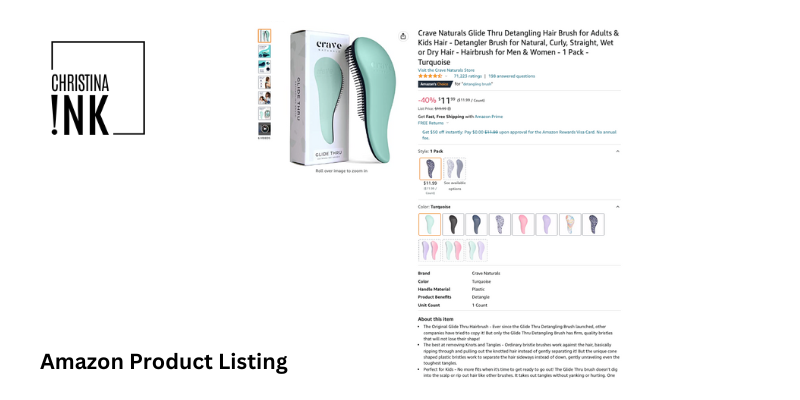The words ‘Amazon A10 Algorithm’ can seem like techy words shrouded in secrecy. But the algorithm and Amazon share a common goal: satisfied, happy customers who return to the marketplace as their number one choice for online shopping. Now more than ever, it’s vital to your success to learn and understand how the A10 Algorithm works and the best tips for improving your Amazon listings if you want your products to be seen and bought.
This article will dive into the hidden truth about the Amazon 10 Algorithm, as well as in-depth information about Amazon listing optimization and prioritization. We’ll also explore product ranking and how you can optimize your listings to unlock better placement in search results. Let’s get the ball rolling without wasting another valuable second.
What Is Amazon A10 Algorithm?
First, let’s begin by saying the obvious: regardless of how cool and attractive your products look, they will hardly sell if they remain hidden on the second page of Amazon SERPs. Second, and probably most important, is the biggest secret the other Amazon marketing agencies don’t want you to know about the Amazon A10 Algorithm…
Ready??
Only Amazon knows it’s algorithm. There is no such thing as the A10 algorithm. Gurus in the space have incorrectly coined the term. But to be clear, the algorithm is actually called A9, as it has been since its conception. Throughout this article, we will refer to the algorithm interchangeably as A10 and A9– not because we are ill-informed, but because we are SEO-savvy copywriters trying to land this article at the top of Google SERPs! (See, we, too, have a few SEO tricks up our sleeve!)
While Amazon marketing agencies like ourselves can study data, review and track insights, and make incremental changes to offer better performance, no guru, coach, or agency can make with 100% certainty guarantees to ranking or listing optimization outcomes. That’s because working with an algorithm means there are certain nuances within that algorithm that we may not be able to control. That’s just the nature of any algorithm, no matter how much we learn, even in 2023.

But don’t think Amazon listing optimization is fruitless. It isn’t. Especially as more sellers flock to the marketplace. Now more than ever, listing optimization and PPC strategy is your best defence. The Amazon algorithm is similar to Google’s algorithm. Even though Google is centered on research and Amazon focuses on shopping, both algorithms are designed to reveal the most relevant results on the first page.
The foundations of the algorithm have evolved over the years. Recent updates have seen a shift in focus, including a major shift towards advertising strategy, relevancy, click-through rate, sales velocity, and the effect of having a range of products in a catalog to determine your overall authority. In 2023, your product needs more than just some pretty pictures and a nice product label to match Amazon’s A10 requirements.
What Is Amazon Listing Optimization?

Amazon listing optimization is the term we use to describe the process of optimizing your digital shelf on Amazon to improve your organic rank so more customers will see your product and click add to cart. The optimization process involves targeting relevant keywords in your product titles and bullet points and uploading professional and attractive infographics, lifestyle images, and videos of your products to seduce shoppers.
Amazon Listing Optimization and the Amazon Algorithm
As an e-commerce platform, Amazon needs to provide users with the most relevant search results. For instance, if someone searches for “clay mask” and a listing of child diapers shows up in the search results, it means that Amazon is not matching the users’ search intent. As a result, many shoppers who are looking for clay masks scroll away to another site instead of spending another few seconds trying a different search term. That is why Amazon relies on the “Amazon A10 search algorithm” to help rank your listings so they can show users the most relevant product(s).
You can remember the differences between Google and Amazon in two key ways:
- Search versus buy
- Research versus shopping
How Does Amazon Prioritize A Listing?

While many Amazon sellers have been trying to crack the mystery of how Amazon prioritizes a listing and therefore ranks products, the reality is that ever-changing rank requirements make it difficult for the average seller to remain in the know. Your branding, logo, e-commerce copywriting, keywords, and product differentiation all play a role in how relevant the algorithm sees your product. The best keywords, the most compelling copy and images, the most satisfied happy customers who leave positive reviews, the most clicks and add to carts, etc., are all factors that determine ranking in 2023.
Customer reviews play a vital role when it comes to prioritization, as most online shoppers value what others are saying about your product. Good reviews will spotlight your brand and can help earn your products a good spot in the SERPs.
Everything else, from keyword relevancy to the quality of your pictures to product availability and sales velocity, all contribute to your ranking or search placement. Amazon listing optimization requires optimizing the entire digital shelf to prove the most effective. Some sellers passionately believe their products are transforming lives when in reality, they’re selling me-too products without differentiation, branding, or the capital to tackle Amazon’s PPC in 2023.
It’s not just one factor that garners top placements of your products on Amazon; it’s multiple factors.
How Do I Optimize My Amazon Listing?

We can break down Amazon listing optimization into seven different sections:
- Product Title
- Product Images
- Copywriting (5 bullet points)
- Below-the-fold Content including A+ Content
- Advanced SEO
- Backend Search Terms
- Reviews and Product Ratings
Every section should lead shoppers through a buyer journey. At the end of each journey, the automatic response should be ‘Add to Cart’. Let’s dive into each section below.
#1 Product Category & Title
You’ll have to search the browse nodes to determine the correct category before listing your products. This important step can greatly impact where and how your products show up. Select the most accurately defined product categories and predefined fields, or customers may not be able to find your product over the sea of others.
In most cases, sellers are allowed 200 characters for a product’s title. But character counts often depend largely on categories, and some categories we’ve seen only permit 80 characters. We max out all 200 characters but place the most important keywords in the first half of the title.
Your product title should provide the shopper with sufficient information so they can decide if they still want to continue with the buying journey. With that said, your title should be readable. We like to add a power word or two and break keywords apart by adding a dash and a space before and after every keyword.
Include the kind of information you want to see if you are searching for a product online. Here are some tips to help you write optimized product titles:
- Capitalize the first letter of each word
- All numbers should be numerals and avoid special characters
- Leverage readable power words so long as they are compliant
- Include the size and quantity toward the start of the title
- Optimize your title for mobile
- Use a dash and a space before and after every keyword phrase
- Avoid promotional messages like ‘sales’ or ‘discounts’
#2 Product Images

Amazon allows sellers to add up to seven product images, and that includes the hero or thumb image. Most products require a white or plain background for the hero image without any packaging or inserts. Show off your product while it is in use by leveraging UGC and lifestyle images. Include a picture of the packaging (or unboxing) so customers can visualize the experience. Your product photos should demonstrate the accurate size of your product. Sometimes size representation can be tricky, and that’s why hiring an experienced Amazon graphic design team is to your advantage. “They didn’t look this small from the pictures” is a very common complaint among online shoppers. Avoiding these types of comments and feedback is essential, so be mindful of sizing and representation.
#3 Copywriting (5 Bullet Points)
Amazon allows sellers up to 10 bullet points to describe their product’s key benefits and features to customers. Only 1000 characters of this prime real estate will rank, so be mindful that length does count. Help your customers visualize their transformation from using your products. To get the most from your bullet points, you can borrow our four styles of e-commerce copywriting that we find most effective in Amazon bullet points:
- Attention Grabbing: Use a copywriting hook in the first half of the bullet point to pique the shopper’s interest and then deliver the related message.
- Benefit First: Explain the key benefits of your product(s), and then back your claims with the most relevant feature.
- Informational: Answer crucial questions that most shoppers will ask right in your bullet points so that customers don’t have to scroll away.
#4 Below-the-fold Content (Product Description and A+ Content)
Think of this as your chance to tell the world why your brand and products are better than other similar products. And you have up to 2000 characters to describe your brand and product in a compelling manner. Try to use as much of that 2000-character limit as possible to show potential buyers why they should consider your product over the competition. Leverage a well-crafted about the brand section so users can easily read your product description and resonate with your message and offer. Be careful not to say so much that you end up misleading potential customers or creating expectations that your product just cannot meet.
This is also where you’ll find your Amazon Brand Story and A+ Content sections if you are brand registered. Capitalize on this real estate as many other sellers may not be enrolled in Brand Registry and have access to these additional sections of stunning imagery and e-commerce copywriting.
#5 Keywords

If you want to optimize your Amazon listings for better ranking and more conversions, you need to know how to incorporate the best keywords into your copy so that your copy is readable and SEO-optimized. But if you want to find the most relevant keywords for your products, you will have to put yourself in the customer’s shoes and think outside the box. Many tools on the market help scrape Amazon’s data to relent the most relevant and highest searched keywords. We use DataDive Tools.
How Many Keywords Should You Leverage in Your Listing?
The number of keywords you unearth in your Amazon keyword research phase will depend on a few factors, including product and keyword demand and how you phrase your product. For example, a knife block can be called a knife set or a knife holder, but they are essentially similar products. Unlocking the best root keywords to perform your keyword research will ultimately determine how many keywords you’re left with. The ultimate goal is to come up with the top 25 to 50 keywords and leverage the top 20 to 25 in your forward-facing listing. Don’t keyword stuff your listing; no matter how visible or well a product ranks, nothing can spell distrust more to customers than copywriting on Amazon that can’t be read easily.
Customers flock to Amazon because they trust the marketplace. Keyword stuffing your listing so that it is not readable does not help your relevancy score, and therefore you’ll be less likely to impress Amazon’s customers and Amazon.
#6 Backend Search Terms
Once you have unearthed your top list of keywords, you will want to use the most relevant ones in your product titles and bullet points. What will be left you can put in the backend search terms field. The Amazon ‘Search Term’ field allows up to 250 bytes for keywords. Note that bytes are different than characters. 1 byte = 1 character for numbers and letters, and = 2 characters for special characters and symbols. The ‘search terms’ or ‘keywords’ that go into this section should be completely different from what you have already used in your Amazon listing, which the customer scans. Nevertheless, you should be careful with how much you put in your ‘search terms’ field. Why? If you exceed 250 bytes in the search terms field, your backend search terms may be ignored.
Apart from the search terms field, you can add other keywords in the ‘Subject Matter,’ ‘Intended Use,’ and ‘Target Audience’ fields. The keywords in these sections should also be very specific to the product’s name.
#7 Product Reviews & Ratings
Your product reviews are so important since they provide social proof about your product and brand. Reviews help shoppers determine trust and quality and therefore are everything to your success. But getting reviews isn’t a walk in the park, especially for newly launched products or if, let’s say, you are a new seller. You can stay ahead of the competition by remaining within Amazon’s code of conduct and delivering a superior product and customer experience. Providing high-quality products and writing ‘copy’ that describes them accurately and outlines their benefits can help compel customers to leave 5-star or 4.5-star ratings and reviews.
What Are Some Common Amazon Listing Errors?
Avoid these Amazon listing mistakes: product titles spammed so heavily with keywords that no part of the title is readable, very common product descriptions and/or bullet points, confusing images, plagiarism, poorly researched SEO, a lack of a cohesive brand theme, and more. If you want to level up your sales in 2023, ask yourself some hard questions:
1. Does your product solve a problem or hit an impulse trigger?
2. What is your budget?
3. Understand that Amazon listing optimization is not a guarantee.
While we will never make guarantees to listing optimization. Our goal is to improve performance and unlock the flywheel effect.
Final Words
Whether it’s a new retail arbitrage product, a private label product, or even a wholesale bundle, at some point, you will need Amazon listing optimization to get your products at the top of page one on Amazon, organically. Product listings that are persuasive and informative enhance your product ranking and increase your sales conversions because they satisfied the most important piece of the Amazon algorithm puzzle– Amazon’s customers.
Take a look at other Amazon listings when shopping for yourself or your family on Amazon. What do you notice, and what insights can you glean from those listings? We encourage all our clients to be unique, create a strong brand position, and amplify that voice across Amazon, your website, social channels, and more. Let us know in the comments if we’ve hashed out some of the secrecy around the Amazon A10 Algorithm! Wink, wink– we mean A9!
If you’re looking to level up your Amazon SEO or are in need of some professional e-commerce copywriting and listing optimization services, we are happy to help! Our experienced team of e-commerce copywriters and Amazon SEO experts can help you unlock your brand position and craft an Amazon listing that stops the scroll.

LIKE THIS ARTICLE?